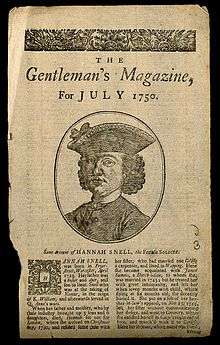Hannah Snell

Hannah Snell (1723–1792) was a British woman who disguised herself as a man and became a soldier.
Biography
Hannah Snell was born in Worcester, England on 23 April 1723. Locals claim that she played a soldier even as a child. In 1740, she moved to London and married James Summs on 6 January 1744.
In 1746, she gave birth to a daughter, Susannah, who died a year later. Snell borrowed a male suit from her brother-in-law James Gray, assumed his name, and began to search for Summs, who had abandoned her while she was pregnant with his child.[1] She later learned that her husband had been executed for murder. According to her account, she joined John Guise's regiment, the 6th Regiment of Foot, in the army of the Duke of Cumberland against Bonnie Prince Charlie, and deserted when her sergeant gave her 500 lashes. However, the chronology of her life makes it very unlikely that she ever served in Guise's regiment and this part of the story is likely to have been a fabrication.
Following the death of her daughter, she moved to Portsmouth and joined the Marines. She boarded the ship Swallow at Portsmouth on 23 October 1747. The ship sailed to Lisbon on 1 November. Her unit was about to invade Mauritius, but the attack was called off. Her unit then sailed to India.
In August 1748, her unit was sent to an expedition to capture the French colony of Pondicherry in India. Later, she also fought in the battle in Devicotta in June 1749. She was wounded eleven times to the legs and once to the groin. She either managed to treat her groin wound without revealing her sex or she may have used the services of a sympathetic Indian nurse.
In 1750, her unit returned to Britain and traveled from Portsmouth to London, where she revealed her sex to her shipmates on 2 June. She petitioned the Duke of Cumberland, the head of the army, for her pension. She also sold her story to London publisher Robert Walker who published her account, The Female Soldier, in two different editions. She also began to appear on stage in her uniform presenting military drills and singing songs. Three painters painted her portrait in her uniform and The Gentleman's Magazine reported her claims. She was honorably discharged and the Royal Hospital, Chelsea officially recognized Snell's military service in November and granted her a pension in 1750 (increased in 1785), a rare thing in those days.

Hannah retired to Wapping and began to keep a pub named The Female Warrior (or The Widow in Masquerade, accounts disagree) but it did not last long. By the mid-1750s, she was living in Newbury in Berkshire. In 1759, she married Richard Eyles there, with whom she had two children. In 1772, she married Richard Habgood of Welford, also in Berkshire, and the two moved to the Midlands. In 1785, she was living with her son George Spence Eyles, a clerk, on Church Street, Stoke Newington.
In 1791 her mental condition suddenly worsened. She was admitted to Bethlem Hospital on 20 August. She died on 8 February 1792.
Cultural references
Playwright Shirley Gee has written two fictional dramatisations of Snell's life: a radio play, Against the Wind (1988) and a stage play, Warrior (1989).[2]
References
- ↑ Margaret Creighton and, Lisa Norling (1996). Iron Men, Wooden Women: Gender and Seafaring in the Atlantic World, 1700-1920. Baltimore: The Johns Hopkins University Press. p. 11.
- ↑ Bradley, B.G. "'Warrior' a feast for senses and mind". The Mining Journal. Retrieved 11 November 2010.
Further reading
- Matthew Stephens - Hannah Snell: The Secret Life of a Female Marine, 1723–1792
External links
| Wikisource has the text of the 1911 Encyclopædia Britannica article Snell, Hannah. |
- Hannah Snell Homepage
- Excerpts from Hannah Snell: The Secret Life of a Female Marine, 1723-1792 by Matthew Stephens
- Royal Berkshire History: Hannah Snell
- Wheelwright, Julie (2004). "Snell, Hannah [alias James Gray] (1723–1792), sexual impostor". Oxford Dictionary of National Biography. Oxford University Press. doi:10.1093/ref:odnb/25975. (subscription or UK public library membership required)